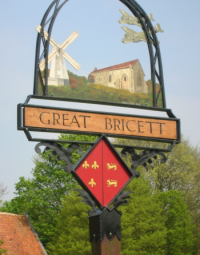
Great Bricett
A Parish in Mid Suffolk

A Parish in Mid Suffolk
When the Romans built a road from Coddenham to Long Melford they routed it through the middle of the Parish of Great Bricett, along what later became known as Lower Farm Road, and in through what is now the main entrance to Wattisham Airfield. Twentieth century excavations revealed evidence not only of some form of Roman dwelling in the area now occupied by the airfield gatehouse, but also signs that man has lived in our Parish continuously from the Mesolithic era to modern times.
When the Romans left, Anglo-Saxons moved into the area and established 2 Manors. It is recorded in the Domesday Book (1086 AD) that the Hamlet of Brieseta had a population of 28, contained 15 beasts, 50 pigs, 140 sheep, and one church. By 1100 only one Manor remained - that of Great Bricett. In 1096, the Lord of the Manor, Ralph FitzBrian and his wife Emma, founded a Priory of Austin Canons on high ground overlooking a stream about half a mile south of the Roman road and dedicated it to St Leonard, a somewhat mythical 6th Century person who founded a monastery at Nobiliac (now known as Saint Leonard) near Limoges in France. The Priory's relationship, if any, to Nobiliac at this time is unclear; it was placed under the protection of the Bishop of Norwich. Together with some other properties he owned, Ralph endowed the Priory with the land and tithes of the Manor of Great Bricett.
A few hundred yards west of the Priory there is a circular mound, known as Nunnery Mount, (Aerial Photo) with a flattened top about 75 yards across, and surrounded by a ditch up to 25 feet deep. Contiguous to it in the south-east, it is just possible to see on the aerial photo the outline of a smaller multi-faceted feature. The exact nature of Nunnery Mount is not known; it's a bit small to be a motte and bailey but it does bear resemblance to early Norman moated features with an adjoining yard. Clearly whoever built it was someone of substance; perhaps the Lord of the Manor. Twentieth century archaeologists speculated that the name may indicate that in Saxon times there was some form of female religious order on the site - perhaps destroyed by invading Danes. However, there is no record of a Nunnery in Great Bricett. Indeed, the earliest map known to show the feature is held by Kings College, Cambridge, and dates to 1725 when it was known as Nunnery Hill; an adjoining field to the north is identified as Nunnery Field, and the “yard” is called “Calves Pitle” meaning a field where calves are kept. It may simply be that the name was a medieval joke connected to the Priory.
A Charter dated 1152 and bearing the Great Seal of King Stephen is in the Archives of King's College Cambridge and granted the village of Great Bricett the right to hold a weekly market and fairs on July 5th and July 6th to mark the festivals of St Leonard and St Lawrence who was the patron saint of the church of Little Bricett situated about a mile further south. However, there is evidence that King Stephen actually granted these rights in 1135, the year of his accession, and that the 1152 Charter merely confirmed the agreement. The Manor and Priory were passed down through several generations and in 1250 Sir Almaric Peche, who had inherited the estates through marriage to the great-granddaughter of Ralph FitzBrian, obtained permission from the Bishop of Norwich to establish a Chantry in his house on condition that all offerings went to the mother church (i.e. the Priory) and that only limited services were held. By 1291 the Priory had an income of £21 per annum and supported between 4 and 6 Canons.
Despite the clear subservience to the Bishop of Norwich which had always been understood, and resistance by the Priors to any connection with the French establishment, the Priory of Great Bricett became a cell of the Abbey of Nobiliac in 1295. Which was a pity because political relations between France and England over the next Century were far from good. Religious establishments deemed to owe their allegiance to foreign countries were classified as “alien”; successive monarchs were prone to dissolve them and confiscate their assets. In 1346, at the height of the Hundred Years War with France, Great Bricett Prior was one of many “Alien” Priors summoned to appear before the Council at Westminster. Finally, in 1414, Parliament passed the Statute of Leicester by which all remaining alien priories, including Great Bricett, were dissolved and their property passed to the Crown. Two years later the Priory was burned and in 1444 all the land belonging to the Priory, including the Manor of Great Bricett, was used to endow one of Henry VI's pet projects - King's College, Cambridge. For most of the remainder of the Millennium King's College were Lords of the Manor of Great Bricett.